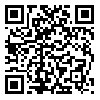Accepted article
Back to the articles list |
Back to browse issues page
1- Department of Rehabilitation Management, University of Social Welfare and Rehabilitation Sciences, Tehran, Iran.
2- Department of Rehabilitation Management, Pediatric Neurorehabilitation Research Center, University of Social Welfare and Rehabilitation Sciences, Tehran, Iran.
3- Department of Clinical Medicine, University of Social Welfare and Rehabilitation Sciences, Tehran, Iran.
4- Department of Biostatistics, University of Social Welfare and Rehabilitation Sciences, Tehran, Iran.
2- Department of Rehabilitation Management, Pediatric Neurorehabilitation Research Center, University of Social Welfare and Rehabilitation Sciences, Tehran, Iran.
3- Department of Clinical Medicine, University of Social Welfare and Rehabilitation Sciences, Tehran, Iran.
4- Department of Biostatistics, University of Social Welfare and Rehabilitation Sciences, Tehran, Iran.
Abstract: (1017 Views)
Objectives: This study aimed to assess the status of hearing rehabilitation services for hearing-impaired students at schools during the Covid-19 pandemic in Iran.
Methods: In this descriptive study, using consensus, educational-audiologists all-over Iran, with a minimum of 2 years of experience in providing hearing rehabilitation services to students, invited to include the study. Participants were asked to complete a web-based questionnaire on how they provide various types of hearing rehabilitation services; face-to-face, tele-rehabilitation, or both and changes in the number of services provided during the pandemic. Face and content validity of the questionnaire approved by 12 experts (CVI=0.70). Participants who did not send back completed questionnaire after three reminders excluded from study. SPSS v. 26 used for data analysis. Also experiences and challenges of the participants in providing tele-rehabilitation were asked by phone-interviews or video-calls, and content analysis used for analyzing data which gathered by interviews.
Results: Forty-three educational-audiologists involved the study. About one-third of audiologists provided parts of their services as tele-rehabilitation, in form of individual or group online counseling sessions for parents, online auditory training sessions for recently cochlear-implanted or first- and second-grade elementary school students, informal assessment of listening and communication skills by observing the child's responses to the parent while doing listening skills exercises during videocalls, providing parents with guidance to address problems with hearing aids, and arranging for hearing aid repair services through postmen and couriers. The most challenging tele-audiology service was formal assessment of hearing skills at the being of school year (score of 4.45 out of a range of 0 to 7).
Discussion: Emphasizes on developing standardized test for tele-assessment of auditory skills of children is mandatory. Sharing the experiences mentioned in the article among educational- audiologists and planners might help in promoting the use of tele-audiology services in pandemic situations like Covid-19 and also improving the coverage of mainstreaming settings and schools far from cities.
Methods: In this descriptive study, using consensus, educational-audiologists all-over Iran, with a minimum of 2 years of experience in providing hearing rehabilitation services to students, invited to include the study. Participants were asked to complete a web-based questionnaire on how they provide various types of hearing rehabilitation services; face-to-face, tele-rehabilitation, or both and changes in the number of services provided during the pandemic. Face and content validity of the questionnaire approved by 12 experts (CVI=0.70). Participants who did not send back completed questionnaire after three reminders excluded from study. SPSS v. 26 used for data analysis. Also experiences and challenges of the participants in providing tele-rehabilitation were asked by phone-interviews or video-calls, and content analysis used for analyzing data which gathered by interviews.
Results: Forty-three educational-audiologists involved the study. About one-third of audiologists provided parts of their services as tele-rehabilitation, in form of individual or group online counseling sessions for parents, online auditory training sessions for recently cochlear-implanted or first- and second-grade elementary school students, informal assessment of listening and communication skills by observing the child's responses to the parent while doing listening skills exercises during videocalls, providing parents with guidance to address problems with hearing aids, and arranging for hearing aid repair services through postmen and couriers. The most challenging tele-audiology service was formal assessment of hearing skills at the being of school year (score of 4.45 out of a range of 0 to 7).
Discussion: Emphasizes on developing standardized test for tele-assessment of auditory skills of children is mandatory. Sharing the experiences mentioned in the article among educational- audiologists and planners might help in promoting the use of tele-audiology services in pandemic situations like Covid-19 and also improving the coverage of mainstreaming settings and schools far from cities.
Article type: Original Research Articles |
Subject:
Audiology
Received: 2023/11/1 | Accepted: 2024/05/1
Received: 2023/11/1 | Accepted: 2024/05/1
Send email to the article author


